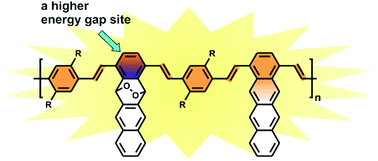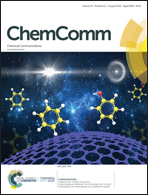Amplifying fluorescent conjugated polymer sensor for singlet oxygen detection†
Abstract
A “higher energy gap” concept was applied towards designing an efficient turn-on amplifying sensor for singlet oxygen – an important biomedical and environmental monitoring analytical target. The concept is based on modulation of intramolecular energy transfer in fluorescent conjugated polymers through the formation of a higher energy gap “roadblock” upon reaction with a target analyte. The polymer sensor incorporates 1,4-disubstituted tetracene units which act as reactive sites for singlet oxygen. The resulting polymer sensor demonstrates significant fluorescent signal amplification and a broader analyte detection range relative to a corresponding small-molecule sensor.



 Please wait while we load your content...
Please wait while we load your content...
